Japanese Architecture: Kyoto’s traditional machiya townhouses
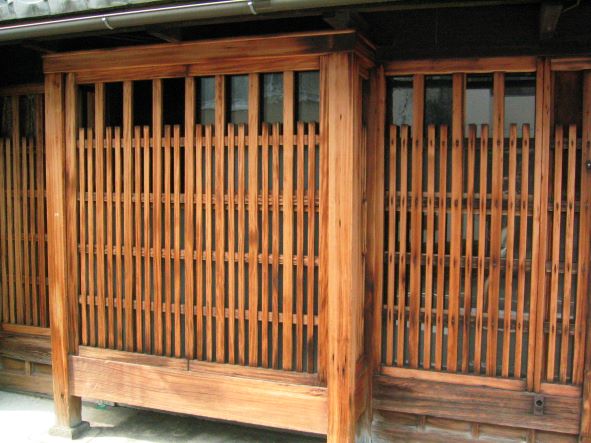
The city of Kyoto is divided into neighborhoods about the size of a city block called cho. Each cho has its own council, known as the chonaikai, which takes care of the security of the neighborhood. Within the chonaikai are road safety groups, groups for organizing sports days, and natural disaster relief groups. Other groups patrol the streets on nights before holidays and festivals encouraging young people to go home early. Fire prevention is a very important part of the chonaikai's activities and every night you can hear people from the fire prevention groups patrolling the streets and banging two sticks together to remind people to turn off the gas before going to bed. They are also responsible for keeping the red buckets in front of houses filled with water.
In the Edo period (1603-1868), smaller units called gonin-gumi ("five-people groups") existed within the cho and consisted of a household, the families in the houses on either side of it, and the houses directly in front and behind it. Every person in the gonin-gumi was held responsible for the behavior of every other member in the group and if one member committed a crime, everyone in the gonin-gumi was punished.
Individual houses called machiya, restricted to two stories by law, were usually the resisdence and place of business of merchant families, who were forbidden to show any signs of prosperity. During the Edo period, taxes were levied on houses in proportion to the width of the frontage, a law which citizens circumvented by extending the backs of their houses. These long, narrow houses came to be jokingly known as unagi no nedoko, or eel bedrooms. Many of these machiya still exist today and whole rows of them are preserved in some areas of Kyoto.
The fronts of machiya in Kyoto have certain interesting design features such as komayose, a wooden railing, and inuyarai, a "dog barrier" made from curved bamboo slats. These barriers originally served the purpose of stopping beggars from sitting against the walls and keeping the houses from being soiled by dogs or splashed with mud by passing vehicles. Now, their function is largely to conceal air-conditioning units.
The windows of machiya are covered by slatted wooden frames called koshi or senbon-goshi ("thousand slat lattice"), which were fitted to try to gain some privacy from the street directly outside. There are various designs of latticework according to the type of premises. Other windows are usually covered by bamboo blinds called sudare. Another unique feature is the battari shogi; a table which folded down from the front wall of the house on which the merchant was able to lay out his wares.
Houses at the corners of the row houses generally became the richest as they had two frontages and quite often bought up the properties next door. These kadoya also had demon tiles on the roofs to deter evil spirits from entering the block. There are very few original kadoya left standing today.
From the Edo period (1600-1868) onwards, machiya served as the residence and place of business for merchant families, who, according to the strict and myriad laws of the Tokugawa regime, were forbidden to openly display any sign of prosperity or ostentation.
Starting in the 1960s, machiya townhouses have been disappearing at an increasing rate. The reasons for the destruction of what many regard to be one of Kyoto’s finest attraction—its old sense of character—are many and varied. First and foremost, many people don’t want to live in a machiya: they want something brighter, bigger and more comfortable. Another reason is Japan’s heavy inheritance tax, which makes it very difficult to avoid selling a property when the owner dies. Another reason is the high cost of maintaining or restoring a machiya property. But not all is lost. There are still plenty of machiya, and some of them are sure to survive for a long, long time.
According to a huge survey done by a volunteer organization trying to preserve machiya, there are about 27,000 machiya left in downtown Kyoto (1998; Nakagyo-ku, Kamigyo-ku, Shimogyo-ku, Higashiyama-ku). Of this total, 3% were built in the Edo period (1600-1868), 24% in the Meiji period (1868-1912), 21% in the Taisho period (1912-1926), 29% in the early Showa period (1926-1940), and 13% after the war. Nearly 50% of machiya in the downtown area are still used as residences, often by generations of the same family.
Recently an increasing number of restaurants, shops and galleries are being set up in old machiya. Here are just a few places that are well worth visiting, even if you only admire them from outside.
Content by Ian Martin Ropke, owner of Your Japan Private Tours (est. 1990). I have been planning, designing, and making custom Japan private tours on all five Japanese islands since the early 1990s. I work closely with Japan private tour clients and have worked for all kinds of families, companies, and individuals since 1990. Clients find me mostly via organic search, and I advertise my custom Japan private tours & travel services on www.japan-guide.com, which has the best all-Japan English content & maps in Japan! If you are going to Japan and you understand the advantages of private travel, consider my services for your next trip. And thank you for reading my content. I, Ian Martin Ropke (unique on Google Search), am also a serious nonfiction and fiction writer, a startup founder (NexussPlus.com), and a spiritual wood sculptor. Learn more!
The Machiya Photo Studio at the end of the Silk Road
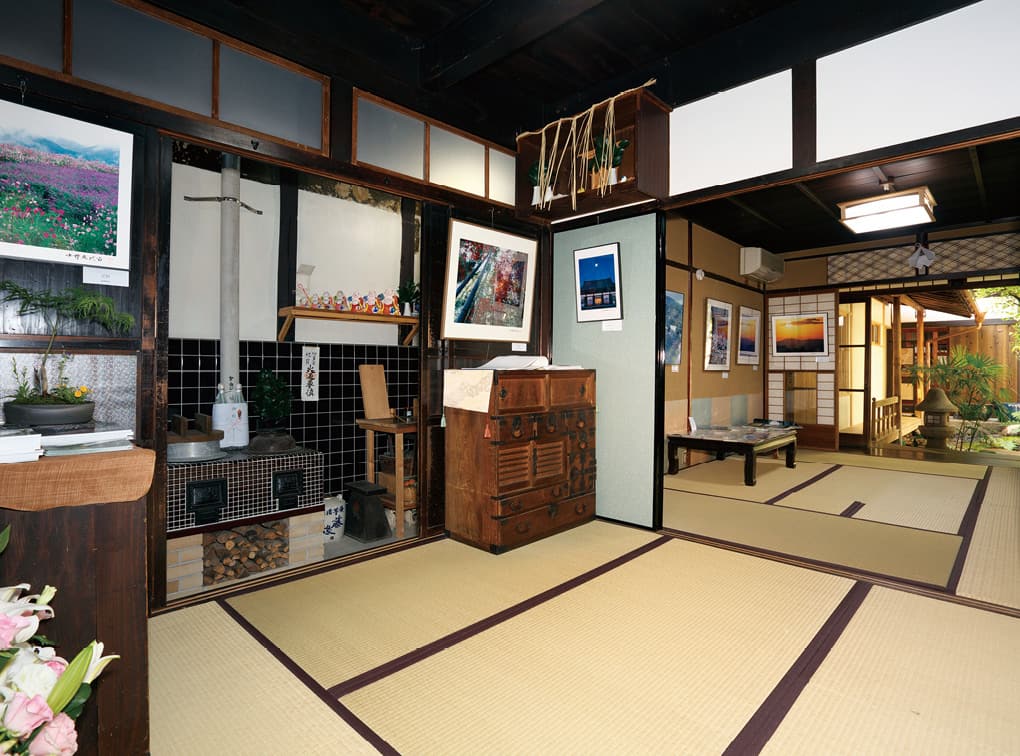
Master Photographer Mizuno Katsuhiko has been recording Kyoto’s incredible and always changing beauty of Kyoto for nearly 50 years. He was born in the Nishijin textile district, which is Japan’s most famous and oldest area for weaving arts. His grandfather was a textile designer in the early Meiji period (1868-1912), when the Nishijin area was still very vital and prosperous.
Mizuno-san was very fortunate to grow up in Nishijin, home to so many craftsmen active in such an intense blend of traditional culture and art. This environment had a immense influence on his future. When he was about 10 years old, his father gave him his first camera. With old post-war Kyoto as his backyard, you could say he was in picture-taking paradise. Over the course of his long career he has published 95 books of photos and essays, of which 90 are on Kyoto (a number of his books area available at Maruzen and other major bookstores). Most of his finest photos are of Kyoto’s gardens and traditional buildings.
A changing selection of Mizuno-san’s works are on regular display in the exquisite Machiya Photo Studio (call in advance to see if they are open). The studio is housed in a restored machiya space. The main room at the back of the building, with a beautiful hardwood floor, has a huge open feeling. There is a loft gallery upstairs overlooking the main room, and a back room facing an old white-washed kura storehouse. All this space makes you want to linger and enjoy the photos and other art. From March 1-5, a selection of Mizuno-san’s photos of old dolls will be on display.
The Machiya Photo Studio is located on the west side of Omiya-dori street in the third block south of Imadegawa (south of Motoseiganji-dori street). The studio is only open if you have made advanced reservations; 11:00-17:00; closed Sundays and national holidays. Tel: 431-5500.
Kasai: Old Gion tea house becomes classy sushi bar
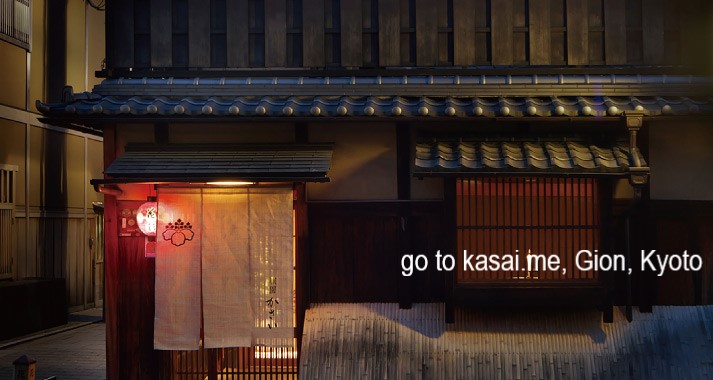
Hanami-koji street, the most famous street in the Gion district, leads south from Shijo to Kenninji Temple, Kyoto’s first Zen temple. Here, in an almost “perfectly" preserved machiya zone, traditional tea houses line both sides of the stone pavement. Most, if not all, of these places are almost impossible to enter without an introduction, even if you are Japanese.
But on the west side of Hanamikoji, 2.5 “blocks” south of Shijo, a sushi shop has opened in one of these tea houses. [A sushi shop that once was a café gallery for owned by a 30 year Gion geiko professional!] The building is over 120 years old, and like many old tea houses it is long and narrow. To learn more about the owner and the place just Google Translate their elegant webpage: kasai.me
Guests who ate there in the summer of 2022 posted these comments: Hidden spot in Kyoto. So refined and such professional staff. A clean, serene, classy restaurant-bar. The master is friendly, and the conversation is fun.
Kasai is open 11:00- 19:00. Closed Wednesdays. It’s about 150 meters south of Shijo on the west side of the street at a corner. Gion Kasai: 570-121 Gionmachi Minamigawa, Higashiyamaku, Kyoto 605-0074, Japan; kasai.me ; Tel: 532-0088.
Mayu: Seven shops, cafe and gallery in an old machiya
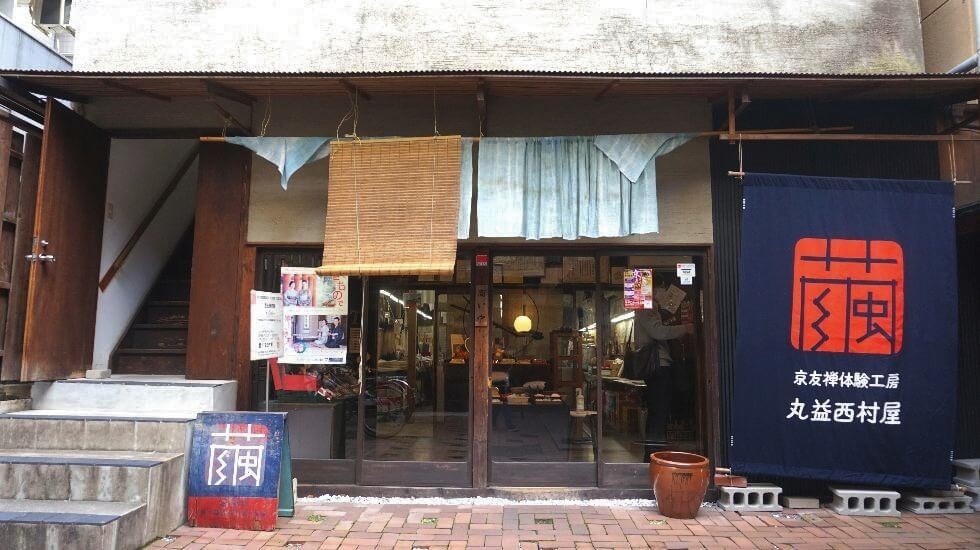
Considering that it’s over 20 years old now, Mayu was on the machiya ambiance trail real early. Mayu was the dream of Mr. Nishimura, a professional yuzen dyer. Making use of a young, talented architect, and several traditional carpenters, it took him nearly 8 months to restore his former home (which was built in the first years of the Showa period. 1926-89). The result is stunning.
Mayu is a great place to hang out and relax for a few hours. There is so much to look at and do. You can visit Mr. Nishimura’s yuzen dyeing studio (make your own T-shirt or table cloth; please reserve at least one day in advance; the studio can handle up to 25 people). The stunning open-air Rumble Fish Cafe (11:00-22:00) serves coffee and lunch. In the shops you will find handmade furniture, ultra-trendy interior goods, Tokyo designer clothing, ethnic goods from SE Asia, a hemp clothing store, etc. Photographers welcome. Come to Mayu and relax in the future of the past.
Mayu is located on the east side of Ogawa, south of Oike (457 Tsuboya-cho, Ogawa-dori, Oike-sagaru, Nakagyo-ku, Kyoto, Japan 604-8276; a 7-minute walk from the Karasuma Oike subway station). Open 10:00-19:00; closed Wednesdays; Tel: 211-3273.
Other machiya townhouse experiences in Kyoto
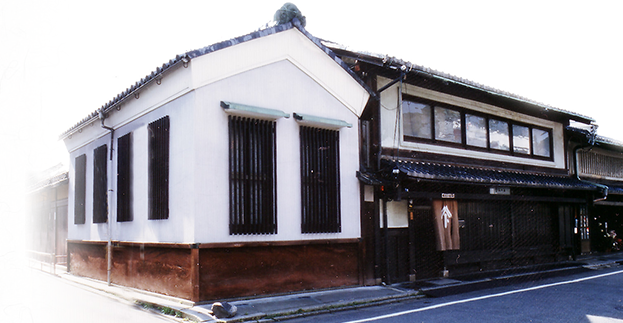
Gion Konishi Gallery: Japanese crafts and daily ceramics, both traditional and modern by Japanese artists, are displayed beautifully in this old machiya townhouse in Gion. Sophisticated atmosphere and elegant space arrangement by Ms. Konishi, the owner and the flower arrangement master. Exhibitions are changed monthly. Crafts are also sold. Open: only when exhibitors are held; 11:00-18:00, closed on Tuesdays. On the west side of Hanamikoji, south of Shijo; https://gionkonishi.com/ ; Tel: 561-1213.
Iori: accommodation and cultural experience: The American manager, Mr. Alex Kerr, is fascinated with Japanese culture and started machiya accommodation to let the people know more about beauty of Japanese tradition; various cultural experience (tea ceremony, noh, flower arrangement, etc.); still going after nearly 20 years and you can also find famous farmhouses managed by Iori on Shikoku Island in the Iya Valley; Tel: 352-0211; https://iori-machiya-stay.hotels-in-kyoto.org/en/
Kawai Kanjiro’s House: This machiya was the residence of the great modern potter, Kawai Kanjiro (1890-1966); he designed the structure and it includes his kilns at the back, his actual living room, staircases that are also chest drawers, and countless Edo-Show artifacts; closed Mon.; 10:00-17:00; one street west of Higashioji, 2 blocks south from Gojozaka; Tel: 561-3585; http://www.kanjiro.jp/
Kinshi Masamune Horino Museum: The building used to be the residence of the founder of one of the biggest Japanese sake makers; in this huge machiya house, just south of the Imperial Palace mega-park, visitors can closely see the old furniture and enjoy freshly made beer;11:00-21:00; on the west side of Sakaimachi, north of Nijo; Tel: 223-2072; http://www.kinshimasamune.com
Miyakoji: Located in the heart of Gion, this fine Japanese restaurant serves excellent, reasonably priced food in a well-preserved, 70-year-old, two-story machiya. Open 17:00-23:00, and weekends at lunch, closed on some Wednesdays. One street north of Shijo, east of Nawate; Tel: 541-0015.
Mizuno Katsuhiko Photo Gallery: Mr. Mizuno, born in Kyoto, is an excellent photographer who has published so many books featuring Kyoto; he opened this gallery in a 130-year-old machiya in the 1990s; advanced reservation required; free; closed Sun. & natl hol.; 11:00-17:00; on the west side of Omiya, south of Motoseiganji; Tel: 431-5500
Shiorian screen and textile museum: Kyoto is the eastern end of the Silk Road that went all the way to Belgium! This machiya typifies the residence of a wealthy Kyoto textile traders: it’s huge, has interior gardens, and is in perfect condition though very old. Valuable large folding screens are exhibited throughout the year, and famously so during the July Gion Festival. Kimono exhibitions and cultural events are held in this magnificent machiya setting; appointment required; closed irregularly; 10:00-17:00; on the west side of Shinmachi, north of Rokkaku; Tel: 241-0215; http://www.shiorian.gr.jp/
Tondaya cultural experience: Originally founded as a kimono fabric shop nearly 150 years ago, Tondaya has been showcasing traditional machiya high culture (tea ceremony, kimono wearing, and more) for 13 generations; https://tondaya.co.jp/
Return to the Japanese culture essay index.
Content by Ian Martin Ropke, owner of Your Japan Private Tours (est. 1990). I have been planning, designing, and making custom Japan private tours on all five Japanese islands since the early 1990s. I work closely with Japan private tour clients and have worked for all kinds of families, companies, and individuals since 1990. Clients find me mostly via organic search, and I advertise my custom Japan private tours & travel services on www.japan-guide.com, which has the best all-Japan English content & maps in Japan! If you are going to Japan and you understand the advantages of private travel, consider my services for your next trip. And thank you for reading my content. I, Ian Martin Ropke (unique on Google Search), am also a serious nonfiction and fiction writer, a startup founder (NexussPlus.com), and a spiritual wood sculptor. Learn more!